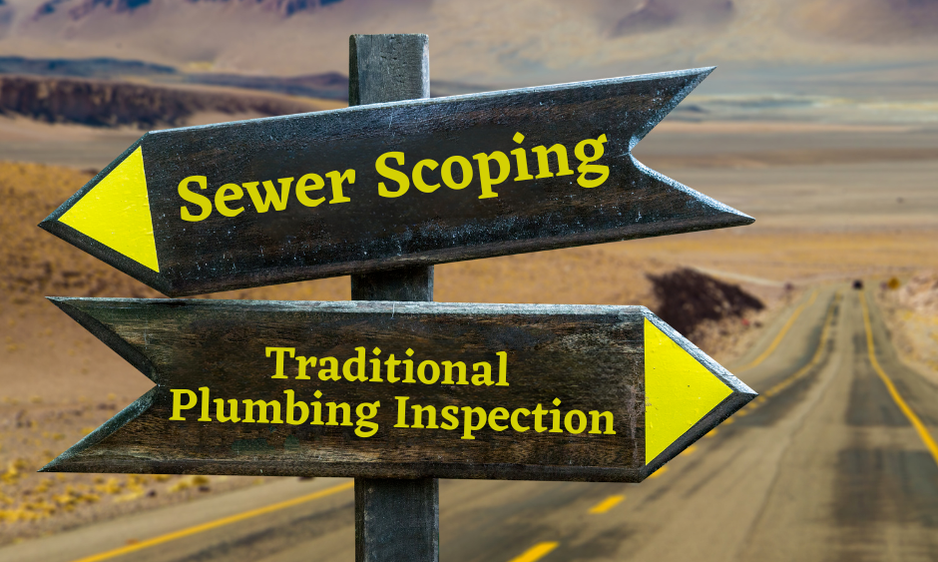Every homeowner has to maintain their sewer system in good working condition. Sewer Scoping and Traditional Plumbing Inspections are two common methods often used when determining the state of your sewer systems. Read on to know more about the difference of these two.

Sewer Scoping vs. Traditional Plumbing Inspection
I. Process
Sewer Scoping employs a specialized camera system to examine the inner components of your sewer lines. By inserting a flexible and waterproof camera into the sewer pipes, the inspector can visually evaluate the pipes’ state, detect obstructions, fractures, leaks, tree root intrusions, and other possible problems. The process involves recording and analyzing real-time video footage, which is then used to create a detailed report encompassing all findings.
In Traditional Plumbing Inspections, the usual practice is to visually inspect the visible plumbing fixtures, water supply lines, and drain systems that are accessible. Plumbers utilize their expertise and basic tools to examine for leaks, water pressure irregularities, apparent damages, and other visible indications of plumbing issues. However, this approach does not offer a thorough evaluation of the interior condition of the sewer lines.
II. Precision and Comprehensive Evaluation
Sewer scoping provides a remarkably precise and in-depth evaluation of the sewer lines. The camera captures crystal-clear images of the inner pipes, enabling a meticulous examination of potential concerns. Skilled technicians can accurately pinpoint blockages, identify their characteristics, assess the extent of pipe damage, and highlight areas susceptible to future issues. This high level of accuracy empowers homeowners to make well-informed decisions regarding necessary repairs or replacements.
Traditional plumbing inspections are capable of identifying noticeable problems like leaks or damaged fixtures, but they lack the thoroughness required to assess the interior condition of sewer lines. Plumbers often depend on external indicators such as slow drains or foul odors to infer potential issues within the sewer system. However, this approach falls short in providing detailed information about the precise nature or location of the problem within the sewer lines.
III. Price
Sewer scoping may involve a higher upfront cost due to the specialized equipment required. However, it offers long-term cost savings by accurately diagnosing sewer line issues at an early stage. This enables proactive repairs or maintenance, preventing more extensive and expensive damage down the line.
Typically, traditional plumbing inspections have a lower initial cost as they rely on basic tools and visual assessments. However, the downside is that they may fail to detect underlying sewer line problems, which can result in more serious issues and increased expenses for repairs in the future.

IV: Time Efficiency
Sewer scoping is a relatively swift procedure that can be completed by the inspector within a few hours, depending on the intricacy of the sewer system and any encountered complications. The real-time video feed enables instant analysis and identification of problematic areas.
The duration of traditional plumbing inspections can vary depending on the extent of the inspection and the number of fixtures that need to be assessed. While simple inspections can be completed relatively quickly, uncovering concealed sewer line issues through this approach may necessitate additional time-consuming investigations.
V: Preventive Maintenance:
Sewer scoping proves to be immensely advantageous for proactive maintenance purposes. By identifying potential problems in their early stages, homeowners can take proactive measures to address them. Regular sewer scoping plays a pivotal role in preventing expensive repairs, reducing the chances of sewage backups, and prolonging the lifespan of the sewer system.
Traditional plumbing inspections prioritize the identification of visible issues that require immediate attention, rather than proactively identifying potential problems within the sewer lines. As a result, they are less effective in offering preventive maintenance measures.

Although traditional plumbing inspections have their advantages, sewer scoping provides a more thorough, precise, and detailed evaluation of the interior condition of sewer lines. It enables proactive maintenance, cost-effectiveness, and a deeper comprehension of potential issues. Opting for sewer scoping allows homeowners to make well-informed decisions regarding repairs or replacements, ensuring the durability and effectiveness of their sewer systems. By understanding the distinctions between sewer scoping and traditional plumbing inspections, you can select the inspection method that best caters to your requirements and safeguards your plumbing system in the long term.
